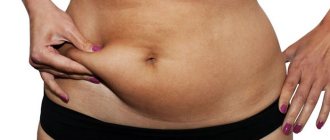Many women who have had a caesarean section are concerned about how their belly looks. Those who gave birth naturally can begin to pump their abs after just a few weeks. Let's figure out how to remove the belly after a caesarean section without harming your health.
Many doctors claim that you can start physical exercises only six months after the external and internal sutures have completely healed. Below we will give some simple tips on how to remove belly fat after a caesarean section.
Tips and tricks
- It should be remembered that you can start exercising when the stitches have completely healed.
- The load should be increased gradually.
- One of the main conditions for losing weight is proper nutrition. Eliminate fatty, sweet, spicy, smoked foods from your diet. Believe me, it will not benefit either you or your baby, especially if you are breastfeeding.
- Wear a bandage, this will speed up the weight loss process.
- Try to sleep on your stomach. This will help the uterus contract faster.
- Take a walk in the fresh air. When walking, walk at a brisk pace for about half an hour.
- Use creams and scrubs for weight loss, they are quite effective in combating a sagging belly.
Former forms
One of the most exciting questions asked by most women who have undergone this operation is the restoration of the figure after a caesarean section: how to reduce its duration and remove unpleasant folds on the abdomen and sides.
The problem is relevant because physical activity, like exercise, sports, fitness, dancing, is simply prohibited in the first 1-1.5 months. And while mothers who gave birth naturally are already working hard to normalize the contours of their bodies, those who have had a cesarean birth only sigh, looking at the saggy “apron” (the so-called postpartum fold). And it’s completely in vain. After all, abdominal restoration after a caesarean section is available to them from the first days of the baby’s birth.
Proper nutrition
- Eat foods rich in iron (boiled lean meat, leafy green vegetables, legumes) and calcium (cheese and yogurt).
- Take vitamin supplements for nursing mothers from Complivit, Elevit, Vitrum, Alphabet, etc.
- Eat often, but in small portions.
- During the recovery period after a cesarean section, it is recommended to drink more juices, fruit drinks, milk, and pure mineral water.
- Eliminate caffeine, fast food, everything fried, marinated, fatty, smoked, salted.
Physical activity
- Walk more.
- Sit on a fitness ball.
- Maintain your posture.
- Suck your stomach in.
- Walk outdoors every day.
- Perform simple housework.
Sports activities
- From the first day to 5-6 weeks after a cesarean section, you need to perform breathing exercises, thanks to which the body’s recovery will be much faster.
- As for physical exercises directly for a tummy tuck, they can be done only 1.5-2 months after the operation. And then only if everything went without complications and the doctor gave his permission.
- There are light gymnastics, thanks to which restoration of the abdominal muscles after cesarean is possible already in the first week after the operation. However, they must be performed extremely carefully, smoothly, without making sudden movements.
- After the stitches have completely healed, you can sign up for a swimming pool, gym, or fitness club, depending on your preferences. All these sports will allow you to quickly restore your former shape after childbirth.
Cosmetics
- Starting from the 3rd week, figure restoration may include the use of various tightening, anti-cellulite cosmetics.
- Make wraps for the stomach and sides at home from kelp, cabbage leaves, and honey.
- Scrubs made from sea salt, table salt or used coffee grounds will also help remove loose folds after childbirth.
- Store-bought masks and creams with the same effect (tightening) must be used extremely carefully so that their use does not cause suppuration of the sutures.
If a young mother sets out to regain her former slimness and become beautiful and attractive again without any folds or sagging on her stomach, restoring her shape is possible if all of the above measures are followed in combination. It's not that simple, but it can be solved. As a last resort, if you don’t have enough time (most of which is spent on the child) or energy (they are still spent at the same address), you can always turn to plastic surgery if you have the finances. She will definitely give you back your flat, tucked-in tummy and slender waist, even after several caesarean sections.
Keep in mind . If you are not sure that you are already allowed to exercise, it is better not to start doing exercises. Restoring your figure is much easier than regaining your health.
Daily Exercise
The belly after a caesarean section can be removed with the help of simple actions that every young mother can perform without spending any effort or time on it.
- Live with your stomach pulled in, in the truest sense of the word. It will be difficult at first, but then it will become a habit.
- When swimming in the sea, pool or even in the bath, give yourself a water massage. Place your clasped palms parallel to your stomach and make pushing movements. Do the exercise until your arms get tired.
- Use a removable shower head to massage. From the right side to the left and vice versa (at waist level), as well as circular movements clockwise.
- If you visit the pool, then do this exercise. Hang on the side, your back should be straight and touch the wall of the pool. Alternately raise your legs bent at the knees to your chest.
- In transport, walking, doing household chores, do the following exercise. Suck your stomach in as you inhale and relax it as you exhale.
In the maternity hospital
The first hours after the operation, the young mother is under the constant supervision of medical personnel in the intensive care unit. During this time, mommy is not allowed to sit down or make sudden movements. It is recommended to get up no earlier than 3–12 hours after surgery. The young mother is regularly examined, the contractile activity of the uterus and the abundance of postpartum discharge are assessed.
At this stage, it is important to follow all recommendations of specialists. This applies not only to physical activity, but also to nutrition.
In the first days, it’s not only difficult for mom to get up on her feet, it even hurts her to cough and sneeze. In order to alleviate your condition, you need to follow a few simple rules in the first weeks after a cesarean section:
- Don't roll over suddenly. First you need to roll your hips over, resting your feet on the bed. After this, turn the case over.
- You need to get up from a position lying on your side. Lower your feet to the floor, rest your hand on the bed and lift your body, now you can stand up. It is allowed to get up only after the recommendations of the attending physician.
- When coughing, be sure to support the stitches with your hands or a pillow. You need to cough with barking sounds without straining your stomach.
- With increased gas formation, which invariably occurs after any surgical intervention on the abdominal cavity, massage or special medications will help. If you are concerned about bloating in the intensive care unit, contact your doctor.
- Visiting the toilet can only be done with a doctor's permission. Don't be afraid to defecate, it won't cause the stitches to come apart. Holding back the urge to go to the toilet can negatively affect uterine contractions or lead to constipation.
Initial loads
- Start these exercises after about 2 months.
- If the belly does not go away after a caesarean section, then your baby will help tighten it. Place it on your chest and try to get up slowly.
- Take a position lying on your side. Raise your right leg 10 times, then your left leg the same amount.
- Take a standing position on all fours. Retract and relax your stomach. Repeat about 10 times. Control all exercises with pain.
- If possible, ride a bike. 20 minutes a day will be enough to prevent the problem from starting.
- Lean in different directions. While the body is not yet ready for serious stress, start doing simple exercises. Place your hands on your waist and bend in different directions 10 times.
- Take a supine position. Place your arms at your sides. Legs should be bent at the knees. Lift your pelvis off the floor surface as high as possible. Repeat the exercise 12 times.
These exercises for the abdomen after cesarean section are performed for about one month. After this, the body will be completely ready for more serious loads.
Normalization of the menstrual cycle
As after a natural birth, after a cesarean section the uterus is a bleeding extensive wound. The healing process is accompanied by discharge called lochia. In the first days they come in the form of blood, then they become sanguineous and mucous.
On average, recovery of the uterus can take from 6 to 8 weeks, and all this time you will have to put up with discharge, which in essence is not menstruation. The time for normalization of the menstrual cycle depends on hormonal levels. Doctors say that the operation does not affect these terms. As with natural childbirth, various factors play a major role here:
- presence of lactation;
- intensity of milk production;
- feeding regimen;
- women's health;
- timing of introduction of artificial complementary foods;
- the presence of chronic pathologies in a young mother;
- features of its nutrition;
- age;
- the lifestyle she leads.
Basically, restoration of the cycle depends on lactation: the longer a woman puts her baby to her breast, the later she will get her period. There are cases when, after a cesarean section, menstruation is not observed even for a year, if the baby has been breastfed all this time. If your child is artificial, and there is still no long-awaited discharge, this is an alarming signal with which it is better to contact a gynecologist.
According to statistics . Everyone is aware of the disadvantages of cesarean section. But few people know that, according to medical statistics, after this operation, the majority of women normalize their menstrual cycle, which was irregular before pregnancy. Thus, periods become more regular and less painful.
Exercises to eliminate a saggy belly after a caesarean section
- Take a lying position. Place your hands behind your head and clasp your palms. Legs should be bent at the knees. Gently lift your head and shoulders off the surface you are lying on. Stay in this position for 10-12 seconds. Control exercise with pain. If no discomfort occurs, repeat it 12 times.
- Take a lying position. Imitate the movement of scissors with your feet. Repeat 20 times.
- Take the same position. Legs should be bent at the knees. Place your hands on your stomach. Pull it in tightly and hold this position for 6 seconds. Relax. Repeat 12 times.
- Another equally effective exercise on how to remove the belly after a caesarean section is performed while lying on your back. Take a breath. Legs should be bent at the knees. Raise your pelvis and pull in your stomach, while squeezing your buttocks. Exhale. Press your head to your chest and lift it up. Stay in this position for a few seconds. Relax. Take the starting position. Repeat 12 times. Follow the sensations. Don't exhaust yourself.
- Take a supine position. Pull your knees towards your chest. Extend your arms to the sides, placing your palms on the floor. Raise your pelvis, your stomach and buttocks should be tense. Throw your hips to the side. Return to the starting position. Repeat the same, only in the other direction. Do this 12 times.
- If your belly does not go away after a cesarean section, try the following exercise. Do it regularly. Sit on a sofa or bench. Then lie down. Place your hands behind your head. Stretch your legs forward, then try to pull them to your chest and straighten them again. Repeat 12 times.
- Take a lying position on your stomach. Stretch your legs, clasp your hands and place them so that they rest on your chin, spread your elbows to the sides. Inhale, lift your head and shoulders. As you exhale, return to the starting position. Repeat the exercise 4 to 6 times.
- Take a position lying on your back. Stretch your arms at your sides. Legs should be bent at the knees. Exhale and pull your feet towards your pelvis without lifting them off the floor. Inhale and straighten your legs. The exercise should be performed at a slow pace 5 times.
- Repeat the same steps, increasing the load, while your hips should be pulled towards your stomach.
Caesarean section: everything a woman should know
I’ll warn you right away that the article is marked 18+ “only women,” which means only for women. No, I have absolutely no objection to the male population reading it, but I think it’s better for them (you) not to know about all the women’s “things”, although...
Just yesterday you were a thin and ringing girl, and now 9 months have passed and you have moved to a completely different league, the league of young mothers. The price for such a transition is beauty, and it is for the birth of a child that a woman pays with her appearance, often receiving a whole bunch of bad things that affect her presentability and appearance. What we are talking about, I think each of you knows, is excess weight and stretch marks, cellulite, and diastasis... we can continue endlessly. A separate point is such a problem as a caesarean section, which leaves its mark on the once flat and beautiful tummy.
Of course, all this is far from making a woman beautiful, but we will not shed crocodile tears over the current situation (what a beauty you were before giving birth), but we will pull ourselves together and carry out conscious work to bring ourselves, in particular, the belly, into form. And we will talk about this further.
Note: For better assimilation of the material, all further narration will be divided into subchapters.
What is a caesarean section?
Let it be known that over the past decade, the rate of caesarean sections has increased by more than 50% . Statistics tell us that about 30% of all women of childbearing age are personally familiar with this operation. In addition, about 60% of all first births occur through CS.
In medical terms, a caesarean section (CS) is a surgical procedure to remove a baby from the mother's abdomen. It takes on average about 45-60 minutes and includes:
- incision of the anterior abdominal wall;
- expansion of the abdominal muscles;
- uterine incision;
- opening of the membranes.
Whether or not to perform a CS is determined only during the birth process itself, and here are the cases in which it takes place:
- when stupor has occurred and the woman cannot push the fetus through the natural birth canal on her own;
- it turns out that the child does not receive enough oxygen;
- the child is in an unnatural position for exit;
- large fruit;
- premature birth;
- the mother has problems with the shape of the pelvis;
- problems with the placenta (closes the opening of the cervix);
- problems with the umbilical cord (for example, a loop appears around the uterus);
- A CS was performed earlier (during the first birth).
Often, a woman in labor may herself ask for a CS in order to make the birth process easier for herself, avoiding long, “pushing” procedures. However, this is not recommended if you are planning to give birth again later.
Is a caesarean section normal?
Absolutely! And not only earthly girls pass through it, but also “stars”, in particular, they once resorted to surgical intervention to extract the fetus:
- Julia Roberts;
- Angelina Jolie;
- Kate Hudson;
- Kate Winslet;
- Britney Spears;
- Madonna;
- Christina Aguilera.
What awaits me after a caesarean section?
Yes, natural childbirth is quite stressful for a woman, but it is devoid of the subsequent struggle with the visual component - scars. After a CS, it is much more difficult for a woman to bring her tummy to its prenatal shape and achieve its flatness and muscle tone. For the most part, it is not possible to get situations “as it was” and have to put up with what is.
Ladies, my dear, you should also know that pregnancy (regardless of how the birth proceeded) reduces the tone of the pelvic floor muscles, which by the way affect the expulsion of the fetus. Therefore, the priority work after childbirth should be not only measures to flatten the abdomen, but also strengthen the core muscles and improve the functioning of the pelvic floor (pelvic floor) muscles.
Another bad thing after childbirth is the separation of the abdominal muscles (abdominal region). After a CS, diastasis usually has a more “severe” form and it takes more time to improve the situation.
So, after a cesarean section, you need to focus your efforts in three areas:
- elimination of diastasis;
- strengthening the strength of the abdominal muscles (deep layers);
- development of the pelvic floor muscles.
How soon can pressing work be performed after a caesarean section?
Every young mother wants to get into good shape as soon as possible after giving birth. However, it is important to observe the rehabilitation period, which is at least 6 months (preferably 9 ). Only after it has passed can you gradually give load to the abdominal and other areas of the press.
The indicated dates do not mean at all that until this time you should sit Marfutki, i.e. with kneading kvass :), no, up to 6 months (after 5-6 weeks after birth) you can:
- use treadmill/stepper walking;
- exercises with your own body weight;
- use stretching;
- practice some yoga asanas.
Actually, we have already formed some idea of what a CS is and what kind of work we will need to regain our former forms, now we move on to the highlight of the note, namely...
Abdominal training program after cesarean section. What is she like?
So, the husband, who came after work, is fed, the apartment is sparkling, the child is snoring, this means that it is time that a woman can devote to herself and her training.
Below is a training program that will allow you to form a flat stomach and tone not only your abdominal muscles, but also your pelvic floor muscles.
- duration of work under the program – at least 2 months;
- number of times per week - 2 2 apart );
- cardio - low intensity, 2 times a week, 2 times (in the morning - on an empty stomach and immediately after abdominal training), duration 35-40 minutes;
- rest with exercises for 30-45 seconds.
The training program itself after a cesarean section (for women who have diastasis) presents the following picture.
In a visual version, the atlas of exercises looks like this.
The second version of the training program after cesarean section (for women who do not have diastasis) is the following picture.
In a visual version, the atlas of exercises looks like this.
So, now you have two ready-made training programs in your hands (with and without diastasis) and nothing prevents you from returning everything to normal, i.e. Make your tummy flat again.
Should I eat for two?
Nowadays, there is such a widespread concept as “eating for two.” But it has long been known that this will not increase lactation. You should not eat everything that comes to hand, and also concentrate on higher-calorie foods, otherwise you will not only not get rid of a sagging belly, but will also worsen the situation.
Now you know how to normalize your stomach after a cesarean section. Photos of women who regularly performed the above exercises once again prove this. If you devote time to practice every day for 3 months, you will certainly achieve the desired results. But don’t get hung up on it and don’t exhaust yourself, because your strength will come in handy. Good luck!











